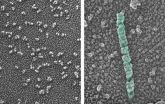(Press-News.org) A simple cut to the skin unleashes a complex cascade of chemistry to stem the flow of blood. Now, scientists at Washington University School of Medicine in St. Louis have used evolutionary clues to reveal how a key clotting protein assembles. The finding sheds new light on common bleeding disorders.
The long tube-shaped protein with a vital role in blood clotting is called von Willebrand Factor (VWF). Made in cells that form the inner lining of blood vessels, VWF circulates in the blood seeking out sites of injury. When it finds them, its helical tube unfurls to catch platelets and form blood clots. Defects in VWF cause von Willebrand Disease, the most common inherited bleeding disorder in humans.
"The challenge for the cell is how to build this massive protein without clogging the machinery," says J. Evan Sadler, MD, PhD, professor of medicine and senior author of the study published in July in the Journal of Biological Chemistry. "The cell has solved this problem by making the assembly of von Willebrand Factor dependent on its location in the cell."
And VWF knows its location in a cell because pH, a measure of how acidic or basic a liquid is, varies from one cellular structure to the next. On a scale of 0 to 14, pure water has a neutral pH of about 7; human blood is slightly basic with a pH of 7.4.
In a cell, the building blocks of VWF form in an area with the same pH as blood. Then these building blocks are shipped to an area that is more acidic. Called the Golgi, this cellular compartment is known for its role in packaging proteins and has a pH of about 6.2. In this acidic environment, the building blocks of VWF are able to form long chains and fold into its signature helical tubules. But how this assembly process works has not been well understood.
From basic biophysics, Sadler and his colleagues knew that only one amino acid in the long protein chain is likely to "sense" a pH change from 7.4 to 6.2. Moving to an acidic environment, this amino acid, histidine, gains a positive charge. The group suspected that this charge may trigger the VWF building blocks to link together in a long chain.
But there are many histidines located throughout the chain. Like 26 letters of the alphabet form thousands of words, 20 essential amino acids form all proteins in the body. To identify which histidines might be guiding the amino acid chain to form the long VWF tubules, Sadler and his team looked to evolution.
"If a particular histidine is important in this process, it should be present in the same location across many species," Sadler says.
So Sadler's group, including the paper's first author, Luke T. Dang, who was an undergraduate student when he did this work, gathered the DNA sequences of VWF for humans, 19 other placental mammals, a marsupial, two birds, a reptile, an amphibian and five fish. Dang is now a graduate student at the University of Washington, Seattle.
"By lining up the sequences, we found a relatively small number of histidines that are in the same place across species," Sadler says. "It then becomes manageable to mutate them individually and see if that prevents von Willebrand Factor from assembling."
Out of the many histidines in the amino acid sequence of VWF, they found two that are important in sensing the pH change and guiding the building blocks to form chains in an acidic environment. When Dang replaced either of these histidines with an amino acid that provides no positive charge, the chain did not form. But when Dang forced a positive charge to always be present at these locations, the chain formed again.
"A positive charge at these positions is important for von Willebrand Factor to assemble properly so it can perform its biological function," says Sadler, also a hematologist who specializes in treating patients with blood clotting disorders. "Without VWF, you bleed."
According to Sadler, defects in VWF disproportionately affect women because the protein is especially important for controlling bleeding during menstruation and childbirth. Sadler says this work helps to better understand the defects in pathways that cause von Willebrand Disease and related conditions.
INFORMATION:
Dang LT, Purvis AR, Huang RH, Westfield LA, Sadler JE. Phylogenetic and functional analysis of histidine residues essential for pH-dependent multimerization of von Willebrand Factor. Journal of Biological Chemistry. July 2011.
This work was supported by the National Institutes of Health (NIH) and the American Heart Association Midwest Affiliate Postdoctoral Fellowship Award.
Washington University School of Medicine's 2,100 employed and volunteer faculty physicians also are the medical staff of Barnes-Jewish and St. Louis Children's hospitals. The School of Medicine is one of the leading medical research, teaching and patient care institutions in the nation, currently ranked fourth in the nation by U.S. News & World Report. Through its affiliations with Barnes-Jewish and St. Louis Children's hospitals, the School of Medicine is linked to BJC HealthCare.
Evolution provides clue to blood clotting
2011-07-22
ELSE PRESS RELEASES FROM THIS DATE:
Landsat satellites track continued Missouri River flooding
2011-07-22
Flooding along the Missouri River continues as shown in recent Landsat satellite images of the Nebraska and Iowa border. Heavy rains and snowmelt have caused the river to remain above flood stage for an extended period.
A Landsat 5 image of the area from May 5, 2011 shows normal flow. In contrast, a Landsat 7 image from July 17 depicts flood conditions in the same location.
A national overview map of streamflow provided by U.S. Geological Survey (USGS) WaterWatch graphically portrays the immense geographic extent of flooding in the Missouri River basin.
Monitoring ...
A new breed: Highly productive chickens help raise Ugandans from poverty
2011-07-22
In the fight to improve global health, alleviate hunger, raise living standards and empower women in the developing world, chickens have an important role to play.
Jagdev Sharma, a researcher at the Center for Infectious Diseases and Vaccinology at Arizona State University's Biodesign Institute has been investigating the advantages of a more productive species of chicken for villagers in rural Uganda. He reports his findings this week at the American Veterinary Medical Association Meeting in Saint Louis, Missouri.
The star of this developing story is a type of chicken ...
Fermilab experiment discovers a heavy relative of the neutron
2011-07-22
Scientists of the CDF collaboration at the Department of Energy's Fermi National Accelerator Laboratory announced the observation of a new particle, the neutral Xi-sub-b. This particle contains three quarks: a strange quark, an up quark and a bottom quark (s-u-b). While its existence was predicted by the Standard Model, the observation of the neutral Xi-sub-b is significant because it strengthens our understanding of how quarks form matter. Fermilab physicist Pat Lukens, a member of the CDF collaboration, presented the discovery at Fermilab on Wednesday, July 20.
The ...
GOES satellite sees a triple header in the tropics
2011-07-22
The GOES-13 satellite captured a triple-header in the tropics today when it captured three tropical cyclones in one image in the Northern Hemisphere.
A visible image taken from the GOES-13 satellite on July 20 at 14:45 UTC (10:45 a.m. EDT) and shows a consolidating low pressure area called System 99L in the eastern North Atlantic Ocean, Tropical Storm Bret several hundred miles east of South Carolina, and a large Hurricane Dora off the west coast of Mexico. The image was created by the NASA/NOAA GOES Project at NASA's Goddard Space Flight Center in Greenbelt, Md.
System ...
It's no sweat for salt marsh sparrows to beat the heat if they have a larger bill
2011-07-22
Birds use their bills largely to forage and eat, and these behaviors strongly influence the shape and size of a bird's bill. But the bill can play an important role in regulating the bird's body temperature by acting as a radiator for excess heat. A team of scientists have found that because of this, high summer temperatures have been a strong influence in determining bill size in some birds, particularly species of sparrows that favor salt marshes. The team's findings are published in the scientific journal Ecography, July 20.
Scientists at the Smithsonian Migratory ...
Unlisted ingredients in teas and herbal brews revealed in DNA tests by high school students
2011-07-22
Take a second look at your iced or steaming tea. Guided by scientific experts, three New York City high school students using tabletop DNA technologies found several herbal brews and a few brands of tea contain ingredients unlisted on the manufacturers' package.
The teen sleuths also demonstrated new-to-science genetic variation between broad-leaf teas from exported from India versus small-leaf teas exported from China.
Guided by DNA "barcoding" experts at The Rockefeller University, an ethno-botanist at Tufts University and a molecular botany expert at The New York ...
UCSF study highlights success of brain surgery for severe epilepsy
2011-07-22
Two-thirds of people with severe and otherwise untreatable epilepsy were completely cured of their frequent seizures after undergoing neurosurgery at the University of California, San Francisco Medical Center, according to a new study that examined 143 of these patients two years after their operations.
The new study not only shows the promise of this type of neurosurgery at treating severe epilepsy, it also highlights how research into brain imaging may help to further improve results for people who have such operations.
"Surgery can be a powerful way to stop this ...
Whole sequence variation map reveals insight into evolutionary studies of rhesus macaque
2011-07-22
July 20, 2011 – BGI (previously known as the Beijing Genomics Institute), the largest genomics organization in the world, and Kunming Institute of Zoology, Chinese Academy of Sciences, together published the whole sequence variation map of rhesus macaque (Macaca mulatta) in Genome Biology on July 6th, 2011 (http://genomebiology.com/2011/12/7/R63). The study provides available resources for evolutionary and biomedical research.
Rhesus macaque, also called the Rhesus monkey, is one of the best known species of old world monkeys. Human and Rhesus macaque share a most recent ...
Cedars-Sinai movement disorders expert on international task force for dystonia treatment
2011-07-22
LOS ANGELES (July 20, 2011) –Neurologist Michele Tagliati, MD, director of the Movement Disorders Program at Cedars-Sinai Medical Center, served on an elite international task force commissioned by the Movement Disorder Society to provide insights and guidance on deep brain stimulation for dystonia, an uncommon condition that causes sustained, sometimes crippling muscle contractions.
The resulting articles, describing the data reviewed and outlining the group's conclusions, recommendations and points to be addressed in future research, published online last month in ...
Computer simulations aid understanding of bacterial resistance against commonly used antibiotics
2011-07-22
A recent study into the interactions between aminoglycoside antibiotics and their target site in bacteria used computer simulations to elucidate this mechanism and thereby suggest drug modifications.
In the article, which will be published on July 21st in the open-access journal PLoS Computational Biology, researchers from University of Warsaw, Poland, and University of California San Diego, USA, describe their study of the physical basis of one bacterial resistance mechanism - mutations of the antibiotic target site, namely RNA of the bacterial ribosome. They performed ...






